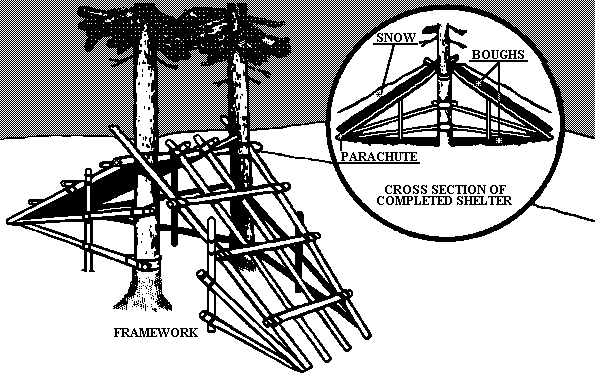This design is by far one of the most familiar and easiest to build temporary shelter.
This is a shelter I built a while back, it fits me, my gear and lots of insulation, not much else. its a good sleeping place and is very warm!
You can build this shelter with or without a tarp and if built right will keep the rain out quite well
Build it double sided to make a tent like structure that will keep out the wind and rain quite nicely.
See below:
Shelter Choices & Materials
Shelter materials come in 3 categories:
1) Structural: Materials in this category are are such things as large saplings, logs rocks, anything that holds weight. In a survival situation, it should be something that is easily procurable and strong enough to withstand the weight of the other shelter materials listed below.
Saplings and large limbs being the structural material used in the majority of shelters , I will concentrate on them
The choices you make in this stage of the shelter building process will dictate what type and what size of shelter you build. Keep in mind that bigger is not always better. A small tight shelter is easier to keep warm via body heat than a larger more airy shelter type.
2) Weather Resistant: This category can contain anything from plastic tarps to pine bows and bark to the shingles on your house. Like shingles, the materials in this category must be able to keep the wind and water out of a shelter and consequently keep you dry and warm. Good examples of natural shelter materials are woven pine bows, thickly piled leaves, reeds, cattail stalks and grass thatch. Your materials choices will obviously depend on your environment.
Note: because I lack the experience necessary to advise about tropical, desert or plains environments, my recommendations will be centered on survival shelter for a temperate environment in either a deciduous or coniferous forest.
3) Insulation: this is the final phase of the shelter. Like the blankets on your bed, Insulation keeps your body heat where it belongs, in your body. select insulation that is prominent in your area. Some ideas might be pine needles, cattail fluff, grass or fur. Basically, you can use any fluffy dry material so long as it is not poisonous and contains no burs . Burs can create sores that will get infected; they are also darn uncomfortable!
Once all of the above goals have been achieved , you might want to take some time and improve your shelter. Perhaps you might want to make it large enough to have a place to build primitive tools and store your gear. A work space is great on rainy days when you are shelter bound and you need to keep busy.
For more information on Primitive Shelters, head to the Hoods Woods web site and order volume 2 of the Woodsmaster Series where Ron takes you into the wilderness and teaches you many valuable lessons that are hard to teach with the written word. Trust me, you will thank yourself!











